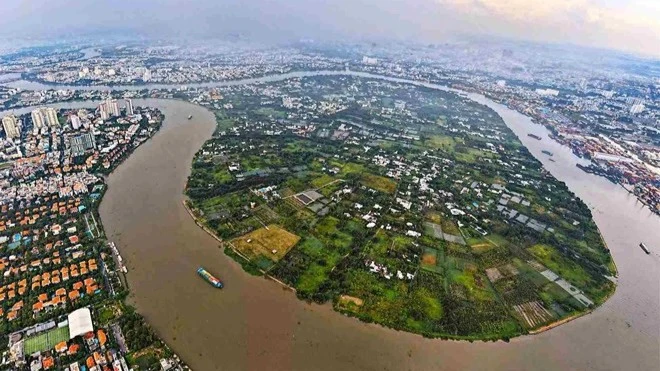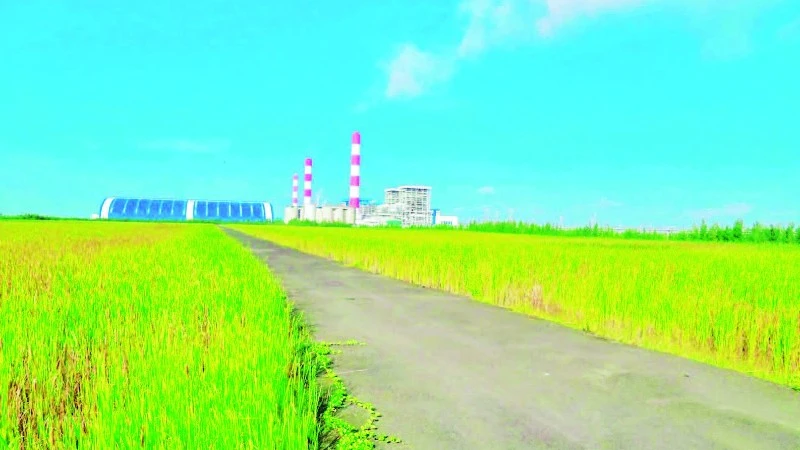By 2030, Hai Phong is expected to evolve into a modern international logistics hub utilising sea, air, expressways, and high-speed rail. With its strategic geo-economic location, which encompasses all five modes of transportation and a gateway seaport, Hai Phong has been steadily advancing towards becoming a logistics centre for northern Vietnam and international markets.
The Red River Delta Regional Planning for 2021-2030, with a vision to 2050, which has been recently announced by the Prime Minister in May 2024, along with Decision No. 323/QD-TTg on the Adjustment of Hai Phong’s General Planning up to 2040, with a vision to 2050, prioritises the development of Hai Phong as a regional, national, and international logistics hub.
Affirming the role as major socio-economic hub
According to Nguyen Hong Son, Deputy Head of the Party Central Committee (PCC)’s Economic Commission, after five years of implementing the Politburo’s Resolution No. 45-NQ/TW, Hai Phong City has asserted its role as a major socio-economic hub of both the Red River Delta region and the nation. The city's socio-economic achievements are impressive, making it a bright spot in the country's overall development. These accomplishments demonstrate the appropriateness of the policies and directions, with the Resolution No.45 proving effectiveness in real life while yielding tangible results.
The PCC’s Economic Commission also noted that over the past five years, Hai Phong's service sector has made significant progress, especially in areas of strength such as seaport services and logistics, with a value-added growth rate of 8.47%. The value of service production in 2023 reached over 265 trillion VND, 1.64 times higher than the figure for 2018.
According to Nguyen Van Tung, Chairman of the Hai Phong City People's Committee, the city promptly developed a specific action plan to implement the Politburo’s Resolution No. 45-NQ/TW and has aggressively pursued its execution. The city consistently identifies logistics as a critical service sector in the overall economic structure, playing a supportive, connective, and driving role in Hai Phong's socio-economic development and enhancing the economy's competitiveness. Along with seaport services, logistics is one of the three key pillars in the city's development strategy.
Thus, Hai Phong has remained consistent in its approach to developing logistics into a high-value service sector, integrating it with the development of goods production, import-export, trade, transportation infrastructure, and information technology, which are crucial conditions for the growth of Hai Phong’s logistics sector.
In fact, in recent years, the city's logistics services have achieved an annual growth rate of 20% to 23%, contributing 13% to 15% of the city's GRDP.
To further enhance logistics activities, Hai Phong has focused on mobilising all resources to develop transportation infrastructure, urban areas, industrial zones, and economic zones, especially the seaport system. Major projects under the Politburo’s Resolution No.45 are included in the list of priority projects for the 2020-2025 period, with the city allocating and attracting investment resources for development.
Among them, many regional and inter-regional transportation projects have been completed, such as the Hanoi-Hai Phong Expressway, the Hai Phong-Ha Long-Mong Cai Expressway, National Highway 5, and National Highway 10, which have been upgraded, renovated, and expanded. The Rung Bridge, Quang Thanh Bridge, Dinh Bridge, Song Hoa Bridge, and Tan Vu-Lach Huyen Bridge and Road have been completed, while the Lai Xuan Bridge is nearing completion, and construction of the Nguyen Trai Bridge is underway.
Between 2019 and 2023, Hai Phong promoted investment in building nearly 20 kilometres of national highways, 29 kilometres of provincial roads, over 55 kilometres of district roads, and more than 137 kilometres of urban roads, creating the most convenient nationwide road connections to and from Hai Phong.
Additionally, the deep-water seaport system has continuously been upgraded. Hai Phong has completed and brought into operation two initial berths at the Hai Phong International Gateway Port in the Lach Huyen Port area, capable of accommodating vessels up to 145,000 DWT. Many major global shipping lines have deployed large container ships to the port, exploiting international sea routes and directly connecting Hai Phong with major ports in Northeast Asia, Europe, and North America.
At the same time, the city is accelerating the construction of six more berths in the Lach Huyen Port area and is implementing further ones. It is expected that by the first quarter of 2025, Hai Phong will have four additional deep-water berths in the Lach Huyen Port area completed and operational.
The city is also focusing on investing in and upgrading 285 kilometres of national inland waterways and 140 kilometres of local inland waterways to develop container transport along these routes. This will not only reduce transportation and logistics costs but also alleviate traffic congestion and accidents.
According to Inland Waterways Administration under the Ministry of Transport, around 80,000 containers and 3.5 million tonnes of goods are imported and exported annually via Hai Phong's seaports using inland waterway transport.
Plenty of room for development
According to the Institute of Industry and Trade Policy and Strategy Research under the Ministry of Industry and Trade, Hai Phong's logistics services have initially demonstrated their importance within the northern key economic region and the Red River Delta. However, compared to its potential and advantages, Hai Phong's logistics sector has not yet developed to its full capacity and has not fully realised its role as a key logistics hub connecting the northern key economic region with the country, the region, and the world.
Logistics costs remain high due to an incomplete infrastructure system, limited information technology, and the weak quality and professionalism of the logistics workforce, currently meeting only 40% to 45% of market demand.
Hai Phong currently has 250 registered logistics companies employing over 170,000 workers, with 60 major warehouses covering a total area of about 701 hectares. However, logistics companies in Hai Phong mainly handle basic tasks such as loading and unloading, warehousing, and road transport, generating low revenue and offering limited value-added services. They struggle to compete with foreign companies such as ONE, Maersk-line, Mitsui O.S.K. Line, and APL, which currently control 75% to 80% of Hai Phong's logistics market.
Furthermore, road transport still accounts for over 80% of freight transportation, while cost-effective methods such as rail and inland waterways have not been effectively utilised. This raises costs, reduces logistics service quality, and increases the risk of traffic congestion and environmental harm.
Assoc. Prof. Dr. Tran Dinh Thien, former Director of the Vietnam Institute of Economics, noted that while the Politburo has approved several breakthrough mechanisms and policies for Hai Phong under Resolution No.45, such as establishing a free trade zone, piloting a one-tier and two-tier urban governance model, and studying a port management authority model, these have yet to be implemented in practice.
Dr. Tran Dinh Thien emphasised that to fully capitalise on its potential for stronger development, Hai Phong needs bold and feasible policies tailored to its specific conditions, along with coordination and synergy among available resources.
Bruno Jaspaert, General Director of DEEP C Industrial Complex, stated that Hai Phong offers immense opportunities for logistics development. Industrial zones located near seaports and within coastal economic zones are leveraging Vietnam’s extensive coastline, facilitating the low-cost transportation of large volumes of goods over long distances. This advantage positions Hai Phong as a growth driver for the seaport and logistics services sectors.
According to Tran Thi Hong Minh, Director of the Central Institute for Economic Management, Hai Phong, with its abundant logistics and free trade zone advantages, should harness its geographical and workforce strengths to accelerate the development of these sectors. With resources such as deep-water ports, traditional seaports, positive results in cargo transshipment, and a strong regional logistics environment, Hai Phong is poised to become a logistics hub for northern Vietnam and even the international market in the near future.
Nguyen Van Tung, Chairman of the Hai Phong People's Committee, emphasised that the city is vigorously working towards the goal of developing Hai Phong into a national and international seaport and logistics hub, as set out in the Politburo’s Resolution No.45.
The city has actively collaborated with ministries and agencies to complete and submit a proposal to the Prime Minister on developing the Southern Coastal Economic Zone — a key growth driver for the city’s socio-economic development and a major catalyst for strong and breakthrough logistics growth in the near future.
This new Southern Coastal Economic Zone, which is planned as a third-generation multi-sector eco-economic zone, will focus on high-tech industries and modern logistics, positioning Hai Phong as a key player in regional and global value and supply chains.
In this area, Hai Phong is expected to develop a coastal expressway, Nam Do Son Seaport, Tien Lang International Airport, two railway lines (Lao Cai-Hanoi-Hai Phong and Nam Dinh-Hai Phong-Quang Ninh), a free trade zone, and several new industrial zones. These developments will create vast new opportunities for Hai Phong’s growth. By 2030, the Southern Coastal Economic Zone is expected to become a primary engine of Hai Phong's economy.
















